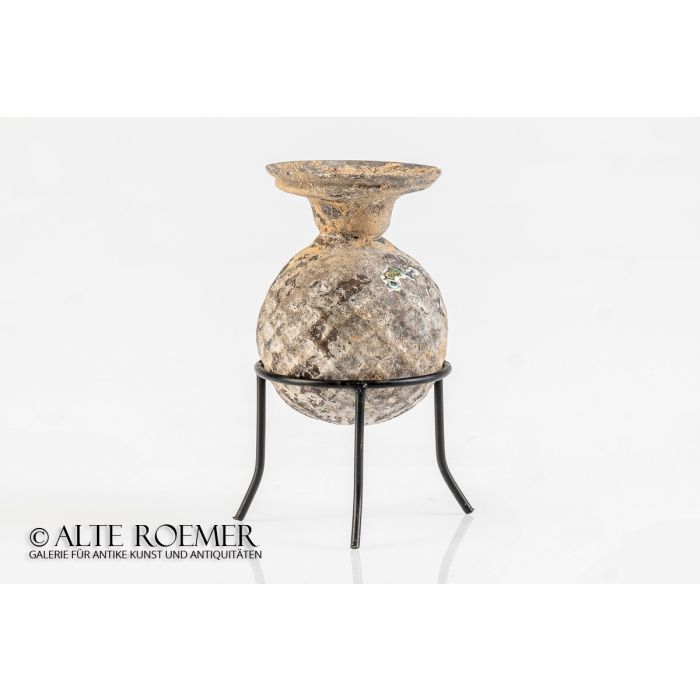Roman sprinkler
Price: on request
Sold
Object number
AR2680-GF06
| Object: |
Roman sprinkler
|
| Material: |
Glass.
|
| Period: |
3rd cent. AD. Roman Imperial. |
| Description: |
Glass flask with spherical body. The short neck is funnel-shaped and terminates in a folded lip. The body was blown into a mold to create a rhomboid pattern. Characteristic for this type of glass vessel is the neck being pushed downward at the time of manufacture. This technique almost fully shut the neck at its base so that liquids can easily be released from the flask drop by drop. Such so-called sprinklers were used for precious contents such as perfume. This type was produced in the Roman province Syria.
|
| Dimensions: |
74mm height (only the flask, without tripod) and 59mm diameter.
|
| Condition: |
Perfect condition. Only small chips at the lip, otherwise intact. Attractive patina. Comes with a modern metal tripod.
|
| Provenance: |
Acquired by us in 2019 from the estate of professor Ritschel, Austria. Exported with the approval of the Austrian federal monuments office. Prof. Dr. Karl-Heinz Ritschel acquired his collection between 1960 and 1970 from international art dealers. Professor Ritschel played an important role for the culture and historical heritage of Salzburg in Austria. He supported the town's cultural development with great commitment. For example, he sponsored the restoration of the Franciscan Church. As a president of the local museum association he was playing a key role in the erection of the Salzburg Museum in the Neue Residenz. The author and brilliant writer manifested his interest in history in over 50 books and 500 columns telling the story of Salzburg. He lived his passion to communicate history to a broader public. For his achievements Karl-Heinz Ritschel was decorated many times, for example in 1995 when the Republic of Austria awarded its Decoration for Science and Art. Also his private collection of ancient art was impressive, focussing on Roman pottery, glass, bronzes and portraiture. We have taken great care to prepare the apparently unpublished pieces with our usual high claim to quality. Now we would like to give them back to the commitment and care of a well-managed collection. |
| References: |
Cf. H. Cantz, Roman, Byzantine, and Early Medieval Glass, p. 245f, no. 131 and 132. Cf. Y. Israeli, Ancient Glass in the Israel Museum, p. 223, no. 274. |
| Authenticity: |
We unconditionally guarantee the authenticity of every artefact, all items are subject to our lifetime return policy on authenticity.
|


